THE GRANADA THEATRE CIRCUIT
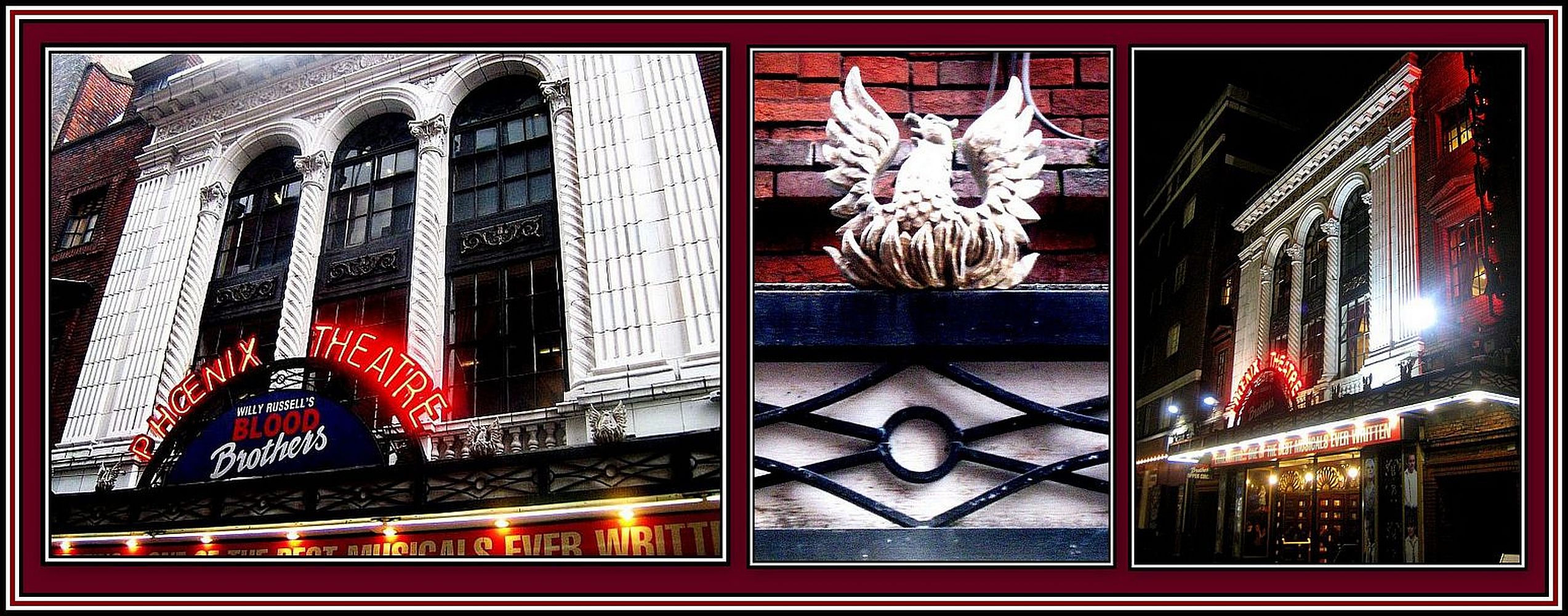 The Phoenix Theatre London – exterior view of the Main Entrance
The Phoenix Theatre London – exterior view of the Main Entrance
——oooOOOooo——
PART EIGHT: THE PHOENIX THEATRE LONDON
The first time I went to the Phoenix Theatre was in 1971. I had just moved back to London and I took friend of mine who was visiting from North America to there to see Canterbury Tales. This was a musical version of some of The Tales which had been written by Geoffrey Chaucer in Middle English at the end of the 14th Century. The musical had been running in London for some time and I remember that it was quite amusing and a little bawdy at times. Apparently the Lord Chamberlain’s ability to censor theatrical productions had recently ended and so the musical play received no critique for its bawdiness.
To be honest, I remember little of the production other than a group of people dressed in medieval clothes swirling in small circles and waving banners, as they moved across the stage to simulate the pilgrims’ journey along the Old Kent Road. I do remember quite enjoying it at the time and laughing a lot at the dialogue. Sadly, I can remember nothing of the melodies of the songs.
At one time, pilgrims from all over Europe traveled to Canterbury Cathedral to visit the burial site of Thomas à Beckett, who had been assassinated in the Cathedral on the 29th December, 1170 and canonised in 1172. When Henry VIII was declared Supreme Head of the Church, England separated itself from Papal authority. Henry VIII went on to order the Dissolution of the Monasteries (1536-1541) and the destruction of Thomas à Beckett’s grave together with the removal of his bones and their destruction. Prior to this, pilgrims regularly set off from Southwark and traveled to Canterbury in groups. This is the setting for Chaucer’s Canterbury Tales, where he describes the journey of a group of pilgrims from various walks of life and who pass each evening by each telling a tale.
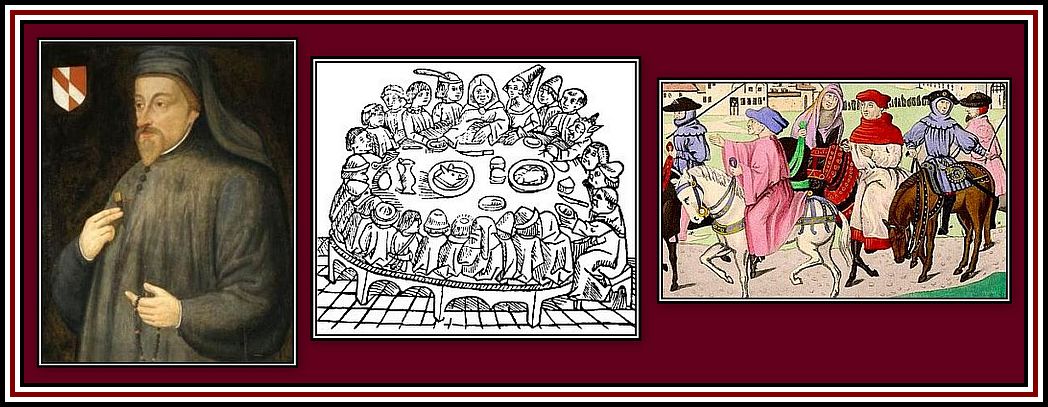 Left: Geoffrey Chaucer (from the 17th Century);
Left: Geoffrey Chaucer (from the 17th Century);
Middle: woodcut from William Caxton’s second edition of Canterbury Tales;
Right: pilgrims on their journey
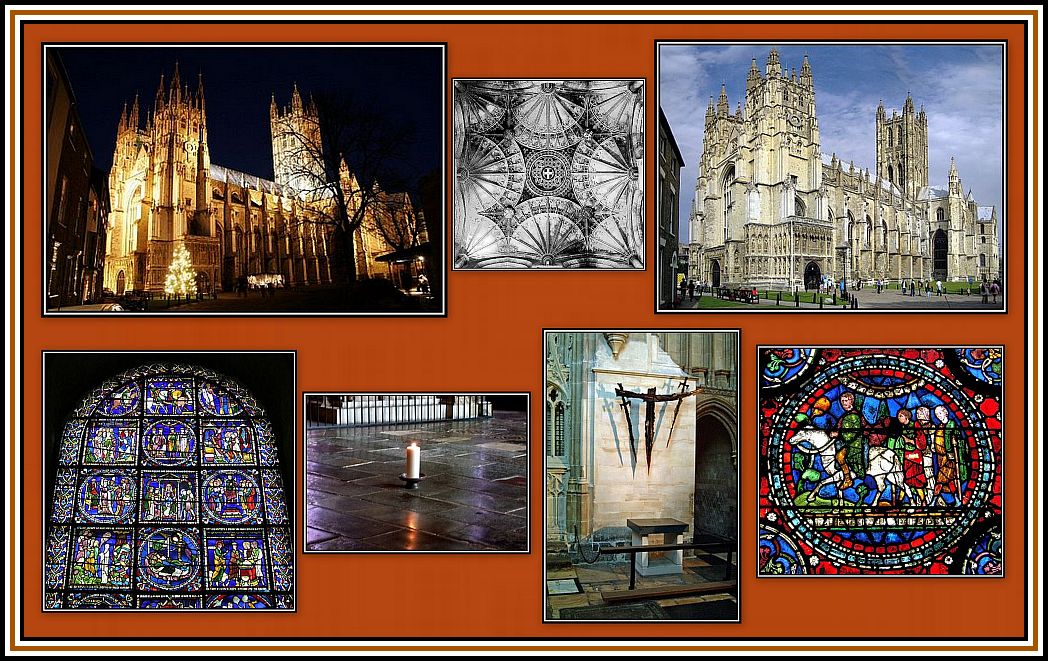 Canterbury Cathedral
Canterbury Cathedral
Top Left: The Cathedral at night; Top Middle: fan vaulting ceiling; Top Left: The Cathedral by day;
Bottom Left: Poor Man’s Bible Window; Middle Left: candle at site of Thomas à Beckett’s gave;
Middle Right: site of his assassination; & Right: Pilgrims
The musical was devised from the collaboration of Martin Starkie and Nevill Coghill and used a Modern English translation of Chaucer’s work to ensure that the text would be convincing.
Seemingly the musical was a huge success in London and in Australia where it ran for a then-record breaking two years. Although it was critically well received on Broadway, and received a number of Tony Award nominations, it was evidently not a success with the public and closed after a mere 121 performances. However, it was more successful during its North American tour.
——oooOOOooo——
But what of The Phoenix Theatre itself? I fear that I did not pay too much attention to the theatre during that visit. I sat in the circle and remember noting (!!!) that the auditorium was decorative (!!!), but evidently little else except for a walkway at the back of the stalls. I noticed this since on the far wall hung a number of posters from past presentations at the theatre.
 The Poster Gallery
The Poster Gallery
I apologise for the quality of these photographs.
As a child and in later life, I have walked down Charing Cross Road many times. I used to enjoy going to the many bookshops that were once there and also at the musical instrument shops that were on the street and on some of the side streets. I have walked by the theatre many times as a child and looked at its exterior that faces Charing Cross Road. Although I liked the curvature of the facade and found it of interest, it was only later that I came to fully appreciate that it was a design of merit.
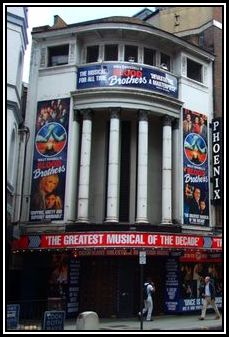 The Phoenix Theatre – Charing Cross Road Entrance
The Phoenix Theatre – Charing Cross Road Entrance
——oooOOOooo——
The second time I went to the Phoenix Theatre was either in 1978 or 1979 when I saw Tom Stoppard’s play, Night and Day. I had seen several of his plays earlier including, Rosencrantz and Guildenstern are dead and Travesties.
I remember well the evening when I saw Rosencrantz and Guildenstern. It was in April or May 1974 in Washington, D.C. I was given a ticket to see the play when it was presented at The John F. Kennedy Center for the Performing Arts, which I thought would be good to see from the inside. The building was huge with a number of auditoria. The building was all glass, plastic and synthetic carpet, as these places always are, and totally without charm and intimacy!
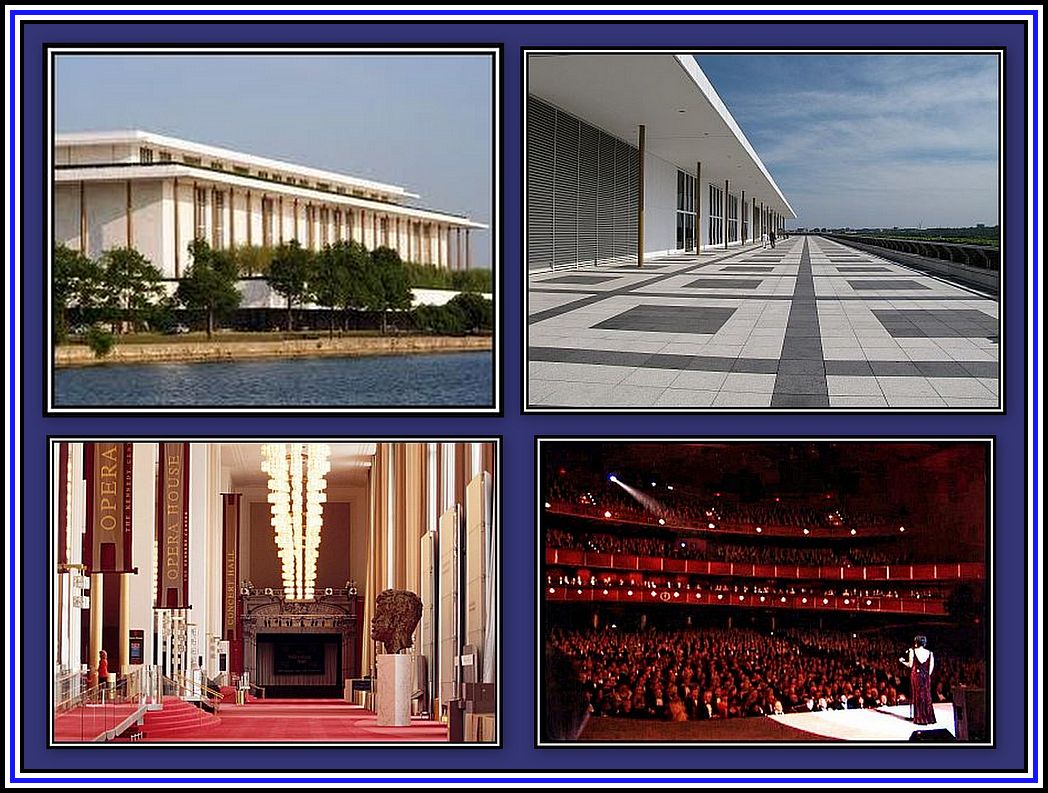 John F. Kennedy Center for the Performing Arts
John F. Kennedy Center for the Performing Arts
The play was being presented by the American Navy and, to put mildly, the production was a disaster! The director obviously had not studied either the play or Hamlet and had poor old Rosencrantz and Giuldenstern attempting to affect an upper class English accent. It was painful to listen to their clipped and idiotic style of speaking. They sounded like a poor-man’s imitation of Julie Andrews.
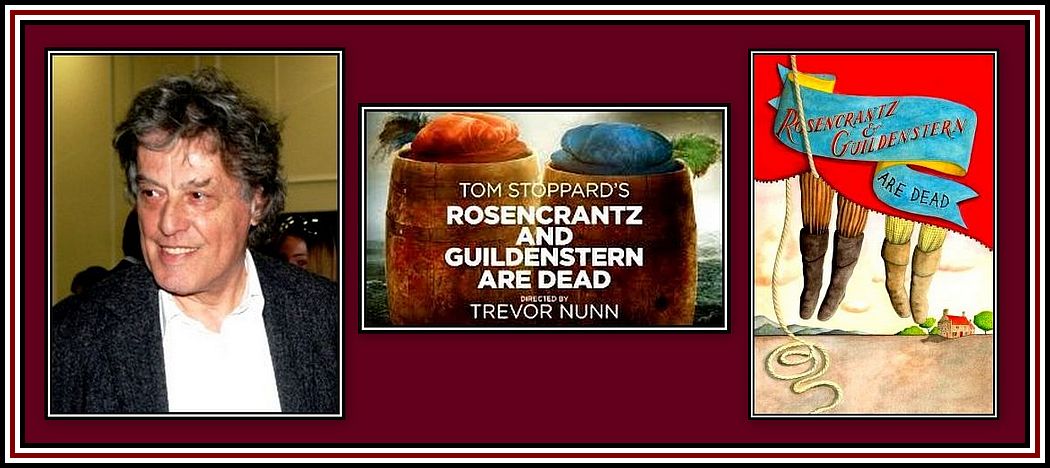 Left: Tom Stoppard; Middle & Right: posters for the play
Left: Tom Stoppard; Middle & Right: posters for the play
I remember that during the interval, a friend who was sitting in a different area of the theatre, found me and made the comment that the play had obviously lost something in the translation! Although his remark was hardly profound, for some reason his observation kept returning to me during the next act of the play and caused me to laugh. Unfortunately, I found that the longer I laughed, the more I laughed. Eventually I could not stop. As the act progressed, I found that I was at the point of choking. I had to stuff a handkerchief in my mouth in the hope of suppressing my laughter (I always take a handkerchief with me when I go to the theatre for such occasions since I have often had to use it especially when watching school productions and other amateur efforts!). Eventually I had to get up and make my way out of the auditorium, much to the annoyance of those around me since I was sitting in the middle of an enormously long row and literally had to push my way past those that would not move!
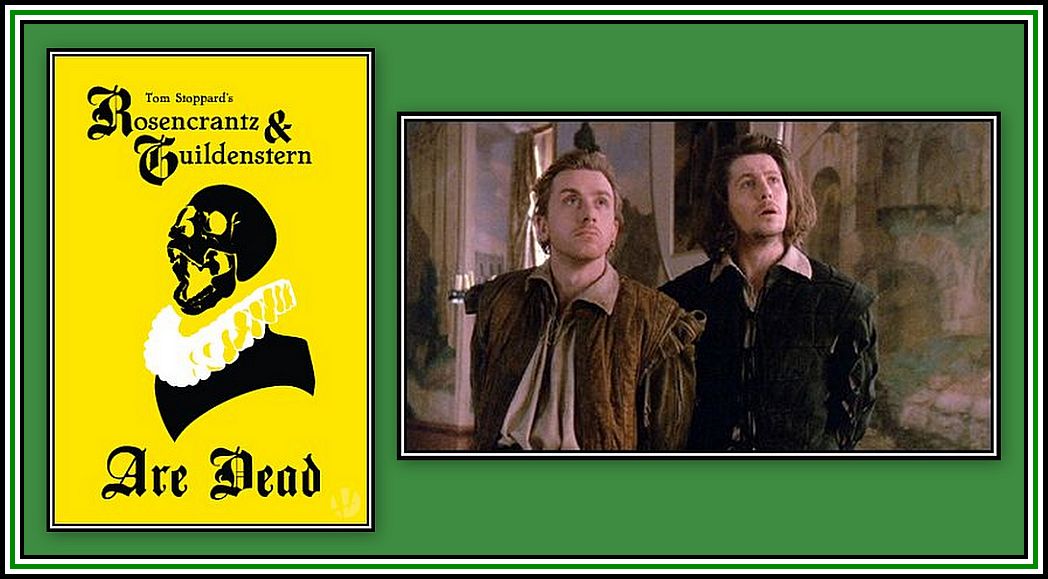 The Film (1990) with Gary Oldham (right) as Rosencrantz & Tim Roth (left) as Guildenstern
The Film (1990) with Gary Oldham (right) as Rosencrantz & Tim Roth (left) as Guildenstern
I saw Travesties soon after it opened in London in 1974. This was not long after my seeing Rosencrantz & Guildenstein are dead and, as a precaution, I made sure that I had my handkerchief with me. Although the play was very amusing, I found myself laughing along with the rest of the audience and so did not need my handkerchief this time. The play did not open at the Phoenix Theatre sadly, but at the Aldwych. The production and cast were excellent and had John Wood playing Henry Carr and Frank Windsor of Z Cars fame as Lenin.
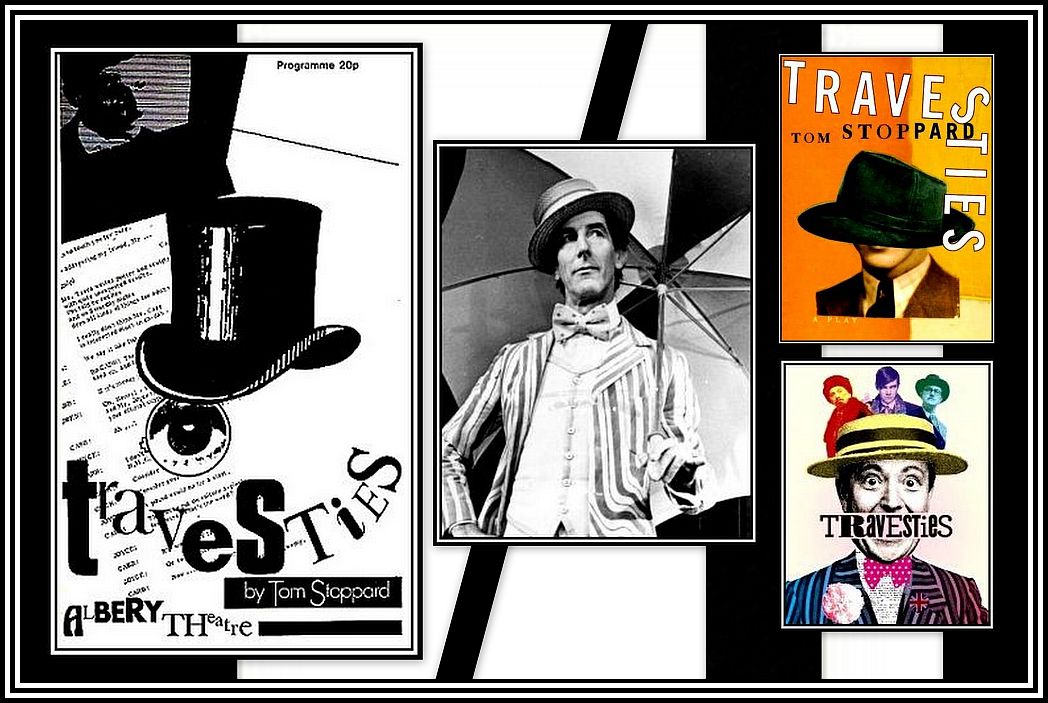 Travesties by Tom Stoppard with John Wood (Centre)
Travesties by Tom Stoppard with John Wood (Centre)
Since then I have seen Tom Stoppard’s The Real Thing twice and Rock ‘n’ Roll once. I went to see The Real Thing on the first occasion as I wanted to see Felicity Kendell. Like most people who saw the television series, The Good Life, I liked Margot, played by Penelope Keith, and Barbara, played by Felicity Kendall, very much. Although I liked Jerry (Paul Eddington), I could easily have left Richard Briers, as I found his portrayal of Tom more than a little irritating. Felicity Kendell played her role in The Real Thing extremely well and I have since enjoyed seeing her in other productions.
 Cast of The Good Life
Cast of The Good Life
Roger Rees appeared in the production of The Real Thing, which was presented at the Strand Theatre. I enjoyed his performance as Nicholas Nickleby, but have not been too impressed with his portrayals since I am sorry to say.
 The Real Thing
The Real Thing
Top Left: London production poster; Middle: Felicity Kendell; Right: Roger Rees
Bottom Right: Broadway production poster
I also saw the play on Broadway. Despite it having an excellent cast including Jeremy Irons, Glenn Close and Christine Baranski, I did not enjoy it as much as the London production.
I remember trying to see the original production of Rock ‘n’ Roll in 2006 and learning that the theatre was closed for a week while the replacement cast rehearsed. I was more than a little miffed. I had come to London especially to do some things including seeing this play. I eventually saw it on a trip to Toronto some time later. Obviously, not only do some of Tom Stoppard’s plays, in my opinion, not translate well, but some also do not travel well either!
To return to Night and Day: I had gone to the play mainly to see Diana Rigg. It had not been too long since she appeared on television in the role of Mrs. Peel in The Avengers and as a Bond girl in On Her Majesty’s Secret Service, which is perhaps best remembered as being the only Bond film with George Lazenby as 007. I remember that the play also had actor, John Thaw, in the cast. This was well before his Inspector Morse days. I cannot say that I was impressed by Mr. Thaw’s acting prior to the Morse Series. I had seen him a few times in the television series, The Sweeney, which I had not liked at all. I also have to admit that it took a while to warm to him as Morse, but was won over by his methods of deduction and, most of all, by the beautiful shots of Oxford and the music – especially the music – both adapted and incidental by Barrington Pheloung.
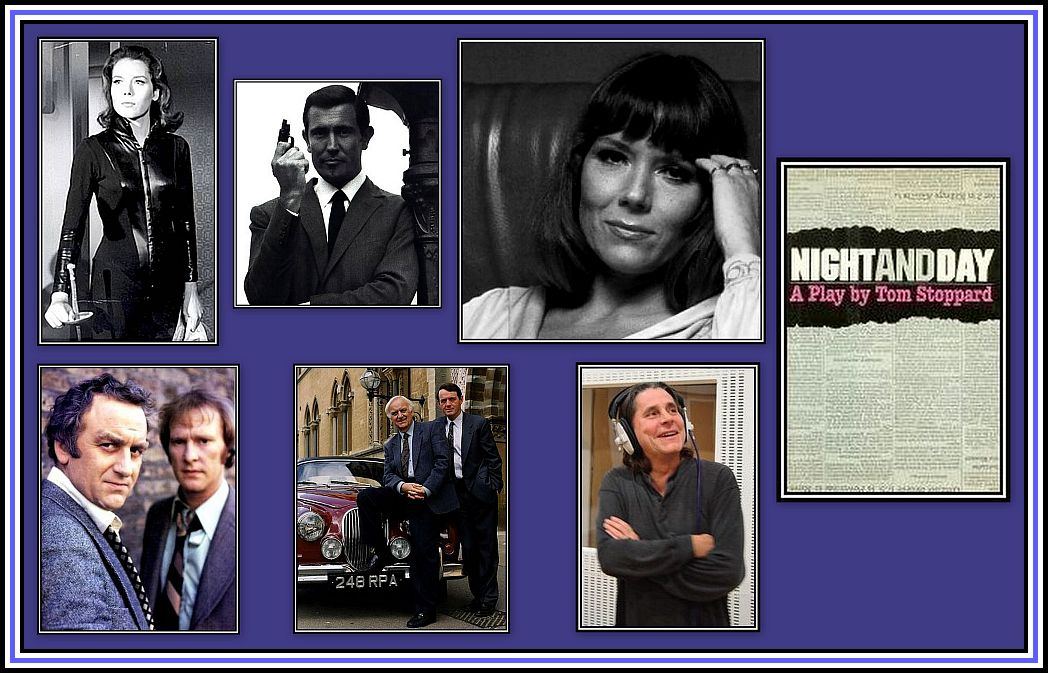 Top Row: Left: Diana Rigg, as Mrs. Peel; Centre: George Lazenby; Right: Diana Rigg
Top Row: Left: Diana Rigg, as Mrs. Peel; Centre: George Lazenby; Right: Diana Rigg
Bottom Row: Left: John Thaw (with Dennis Waterman), as The Sweeney;
Centre: as Inspector Morse (with Kevin Whately & The Jag); Right: Barrington Pheloung
——oooOOOooo——
The last time I went to the Phoenix Theatre was quite recent. I went to see the musical play, Blood Brothers by Willy Russell, which played at the theatre between 1991 and November 2012 after its transfer from the Albery Theatre. I have enjoyed the plays of Mr. Russell that I have seen, which included Educating Rita and Shirley Valentine. He has an innate ability to express the thoughts of working class women who lacked the opportunity to fulfill their dreams. For some unknown reason, I kept missing seeing Blood Brothers. Eventually, I heard that it was about to close and so I decided that it was now or never and finally went. I enjoy it and, despite it having played at the theatre for some twenty years by the time I saw it. I found the production still remarkably fresh with good performances given by all.
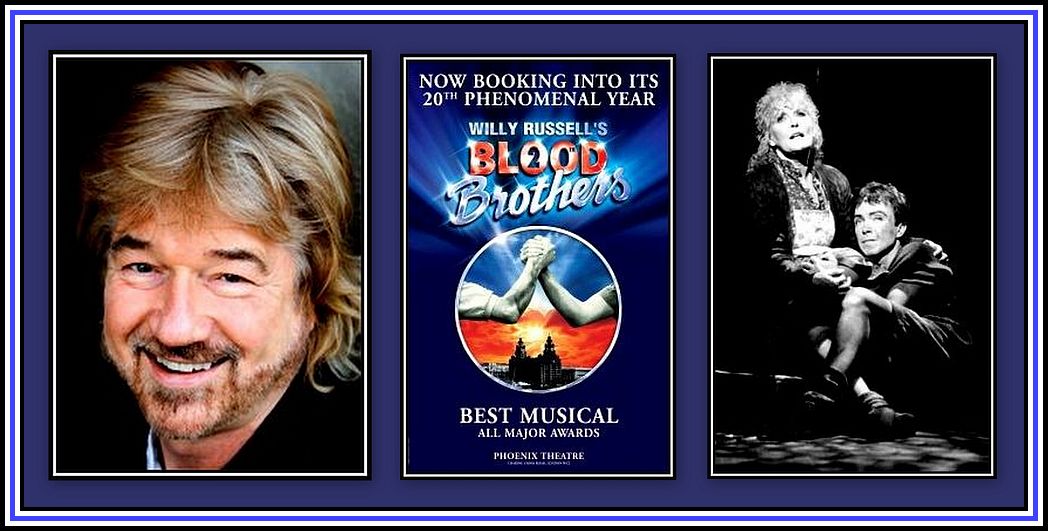 Blood Brothers
Blood Brothers
Left: Willy Russell; Centre: poster for production at the Phoenix Theatre;
Right: Petula Clark & David Cassidy appeared in the Broadway production
as part of a replacement cast
On the evening I went to see Blood Brothers, I arrived at the theatre early to give myself plenty of time to wander around quietly and unnoticed. It was during this visit that I really looked at the theatre for the first time. I was surprised to discover a number of decorative features that were to appear later in theatres of The Granada Theatre Circuit. I found the theatre’s decorative style to be remarkable. Personally, I believe its decor makes it one of the most spectacular of all London’s theatres.
——oooOOOooo——
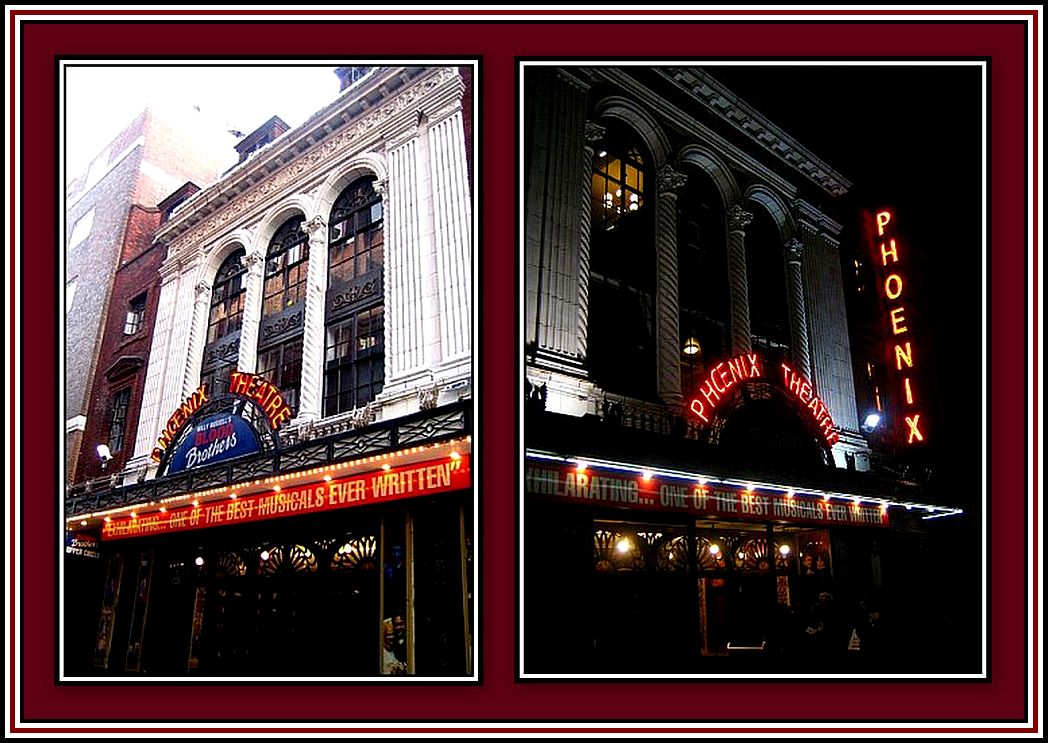 The Phoenix Theatre by day and by night
The Phoenix Theatre by day and by night
At about the same time Sidney Bernstein was having the Granada Theatre Walthamstow built, he became involved in the construction of the Phoenix Theatre in London. Apparently Bovis Ltd., the construction company that built both the Granada Theatres Dover and Walthamstow for him, were now involved in the building of a new London theatre in Phoenix Street, just off the Charing Cross Road. The theatre was built on the site of a factory and later the Alcazar Music Hall. Apparently, this project was not going well and Sidney Bernstein was asked to take it over. He agreed and did so together with Victor Luxembourg.
Sidney Bernstein asked Cecil Audrey Massey together with Sir Giles Gilbert Scott and Bertie Crewe to work on the exterior and auditorium shell and Theodore Komisarjevsky to design the interior decor.
The Phoenix Theatre has two entrances: the main one on Phoenix Street and the second, on Charing Cross Road.
Although there are two glass-paneled wooden doors at the entrance on Charing Cross Road, I can honestly say that I have never noticed them being used. However, I have been assured that they are. Obviously, I have been less observant than I thought.
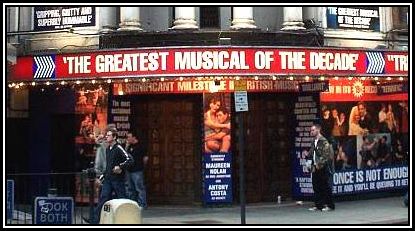 Doors of the entrance on Charing Cross Road
Doors of the entrance on Charing Cross Road
Apparently Sidney Bernstein had to reject Bertie Crewe’s original design for the theatre entrance on Charing Cross Road and asked Sir Giles Gilbert Scott to design another. Mr. Scott was an architect of merit who designed the Anglican Cathedral in Liverpool, Battersea Power Station, Waterloo Bridge and the London red telephone box. He also designed the William Booth Memorial Training College in Camberwell (this will be part of a future story on The Salvation Army).
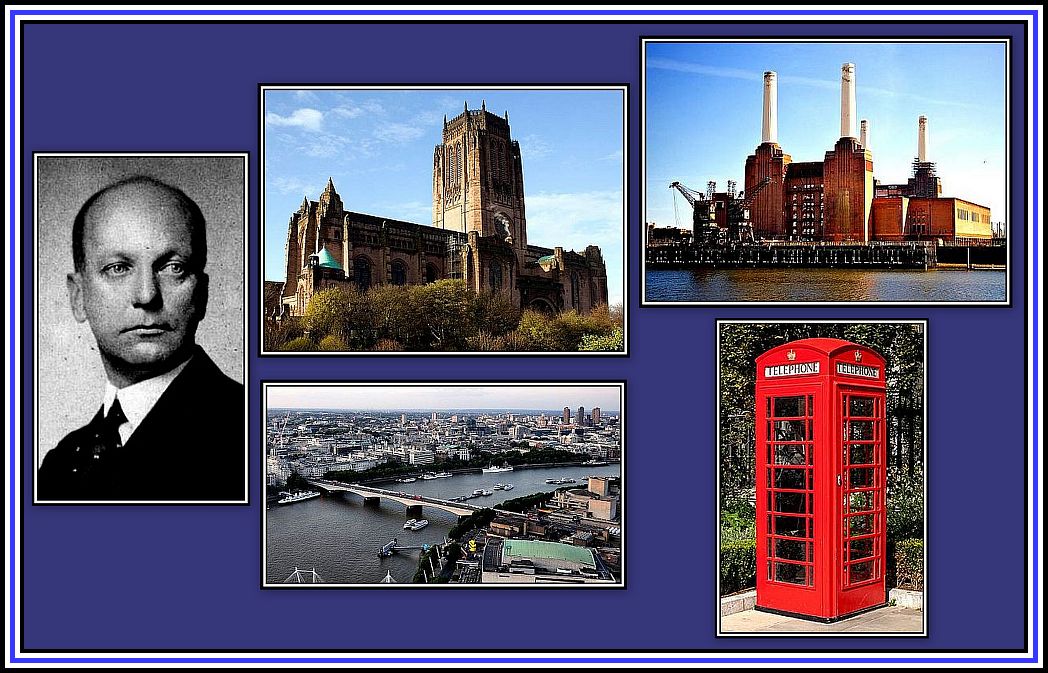 Sir Giles Gilbert Scott (1880-1960)
Sir Giles Gilbert Scott (1880-1960)
Middle: Top, Liverpool Anglican Cathedral; Bottom, Aerial view of Waterloo Brige
Left: Top, Battersea Power Station; Bottom: London telephone box
Bertie Crewe’s design for the entrance included a campanile with a beacon at the top to advertise the theatre’s presence. The design was not appreciated by the authorities and caused Mr. Bernstein to seek help elsewhere. A campanile is an Italian free-standing bell tower associated with a church and first appeared between the 7th and 10th Century. Elaborate examples of this architectural form are the Leaning Tower of Pisa and St. Mark’s Basilica in Venice.
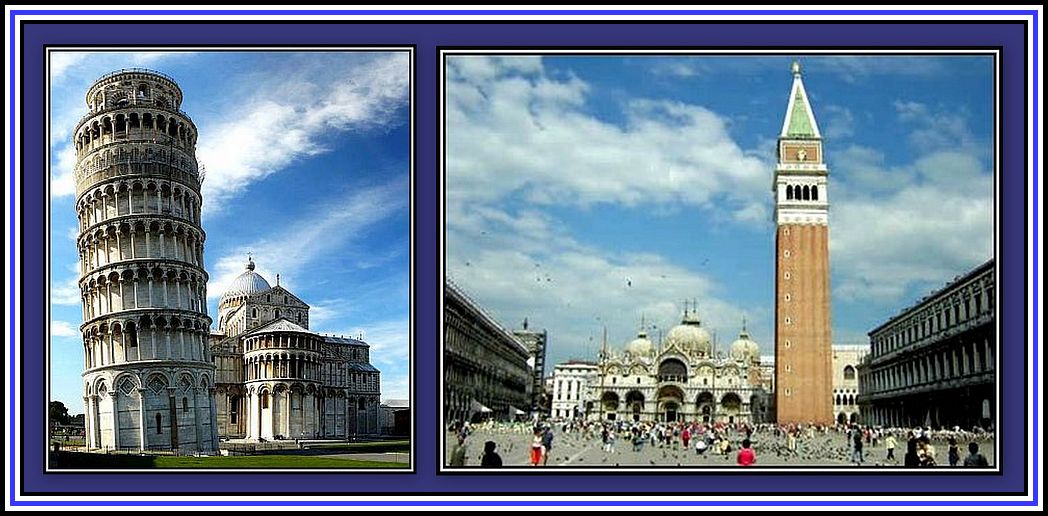 Examples of Campaniles at Pisa (Left) and Venice (Right)
Examples of Campaniles at Pisa (Left) and Venice (Right)
The entrance proposed by Sir Giles Gilbert Scott was of a much more elegant design. It consisted on a curved facade with a recess and four Corinthian columns supporting an entablature. An entablature is a superstructure of moldings and bands, which lie horizontally above columns and rest on their capitals. Above this, on a area of the facade, was once displayed the name of the theatre. Above this is an balcony with a number of upright supports helping to support a small projecting roof. The entrance is especially attractive at night when the recesses of the balcony and area behind the columns are illuminated.
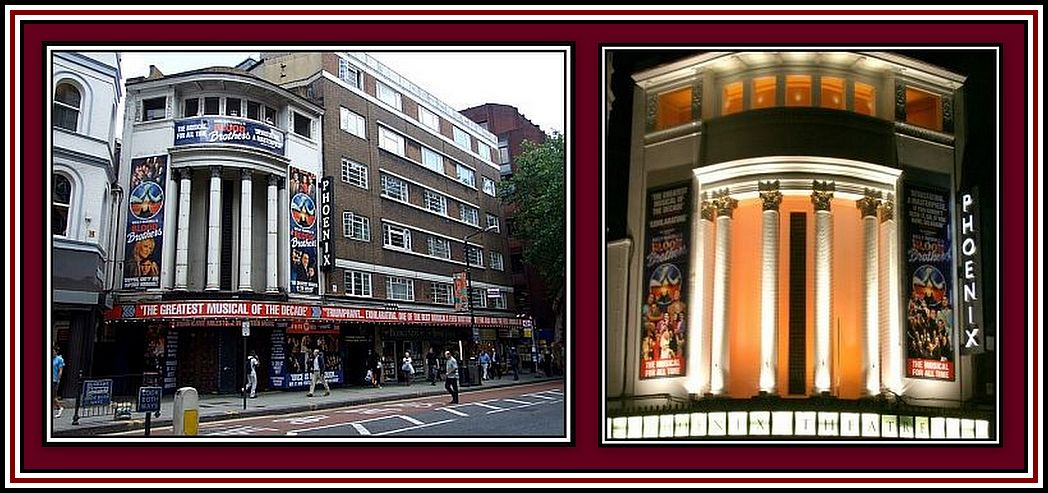 The theatre entrance on Charing Cross Road designed by Sir Giles Gilbert Scott
The theatre entrance on Charing Cross Road designed by Sir Giles Gilbert Scott
There is a small canopy projecting from the facade above the entrance. It sweeps over the entrance and continues across the adjacent building on Charing Cross Road and eventually stretches around the corner to join the canopy extending over the Phoenix Street entrance. Recently, the advertisement on the canopy over the Charing Cross Road entrance have been removed and reveals the name of the theatre spelt out on glass plates, which is illuminated at night.
 The Theatre Canopy stretching along Charing Cross Road and into Phoenix Street
The Theatre Canopy stretching along Charing Cross Road and into Phoenix Street
I have to confess that I did not realise that the Charing Cross Road entrance was actually in use. As a child, I can not ever remember seeing anyone use it. I recently learned that the entrance leads into a small rotunda where there is a box office. Seemingly, the entrance is considered too small by the Fire Services for audiences to use and it closes once the auditorium doors open prior to a performance. Meanwhile the box office at the Phoenix Street entrance remains open until shortly after the start of the evening performance.
I have read that the entrance on Charing Cross Road opens into a small rotunda with the box office on one wall. The rotunda is supported by a series of red and gold Corinthian columns with a frieze around it with the names, in Latin, of those responsible for constructing the theatre. I intend to final use this entrance and see the inscription during my next visit to London!
The façade of the main entrance of the theatre on Phoenix Street is lined with white glazed tiles with three rounded-top windows separated by spiral Corinthian columns and with pilasters at either side. There is a frieze above the windows separating them from a small projecting decorative roof. Above the canopy is the illuminated name of the theatre in a semi-circle along with a series of small phoenix rising from the ashes. There are three pairs of glass-paneled wooden doors that lead into the entrance area and box office.
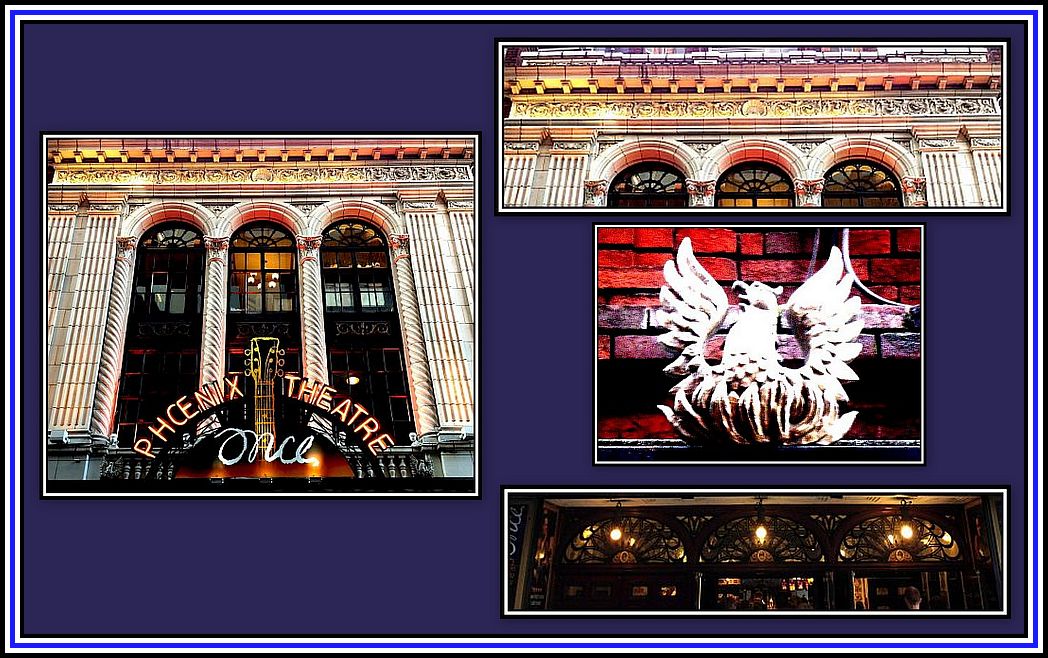 The Phoenix Theatre – The main entrance on Phoenix Street
The Phoenix Theatre – The main entrance on Phoenix Street
Left: rounded-topped windows & columns and theatre name;
Right, Top: frieze and roof;
Right, Middle: one of a number of decorative phoenix rising from ashes;
Right, Bottom: three pairs of outer glass-paneled wooden doors
——oooOOOooo——
Mr. Komisarjevsky chose Italian Renasissance as the decorative style for the theatre and wrote that he chose it because it was lighter than Baroque and more suitable for theatres and other places of entertainment. He also wrote that he based his design on the courtyard of the Palazzo Boncompagni built in 1538 in Bologna, which is the birth place of Pope Gregorio (Gregory) XIII. Pope Gregory XIII was responsible together with Christopher Clavius, a Jesuit Priest and astronomer for reforming the calendar. The Gregorian Calender replaced the Julian Calender in 1582 and has become the internationally accepted civil calender being recognised by the United Nations and the Universal Postal Union.
The wooden doors open into a small entrance area with the box office on the right, as with the Granada Theatre Walthamstow, and a cloak room on the right. The box office is surrounded by highly decorative pilasters in gold including a phoenix motif and a coffered ceiling with concealed lighting around the rim. The entrance area is separated from the foyer by a second set of glass-paneled wooden doors.
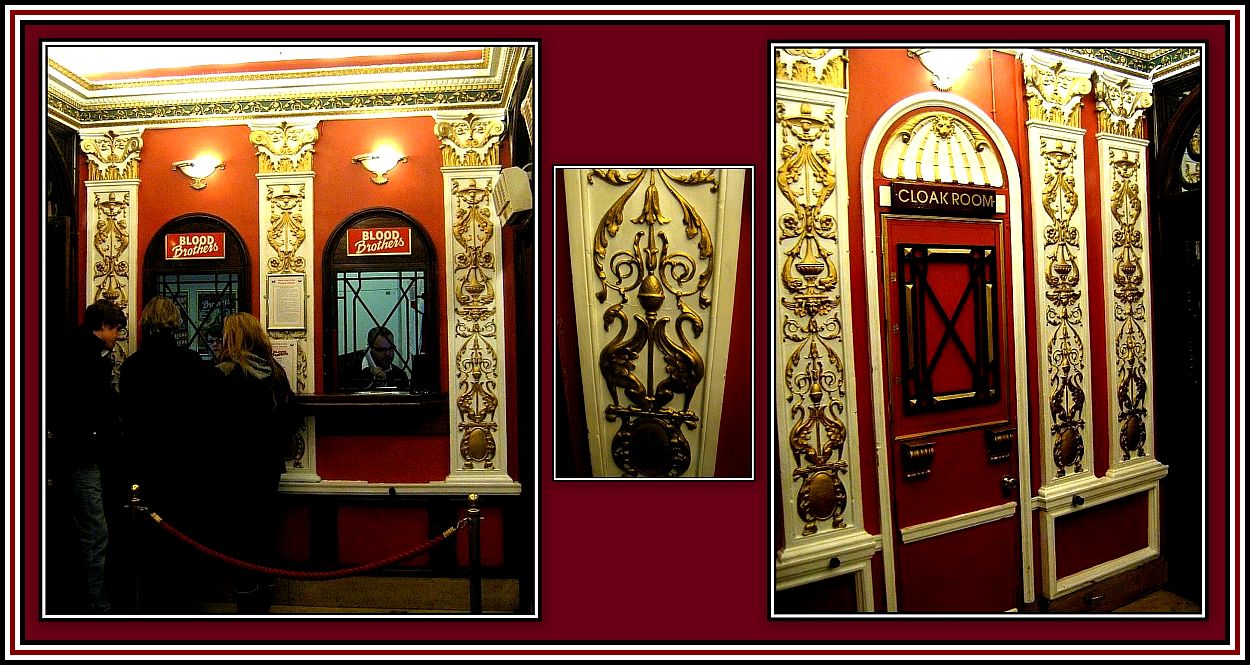 Box Office & Cloak Room in the entrance area
Box Office & Cloak Room in the entrance area
Although the rectangular foyer is small, it has been decorated in spectacular fashion. The ceiling is elaborate and consists of alternate rows of highly decorated sunken octagonal panels or coffers in green, gold and red with a central gold motif and small diamond coffers in green and gold. When first seen, the ceiling makes for a breathtaking sight and when seen a second, and third time, proves to be equally as impressive.
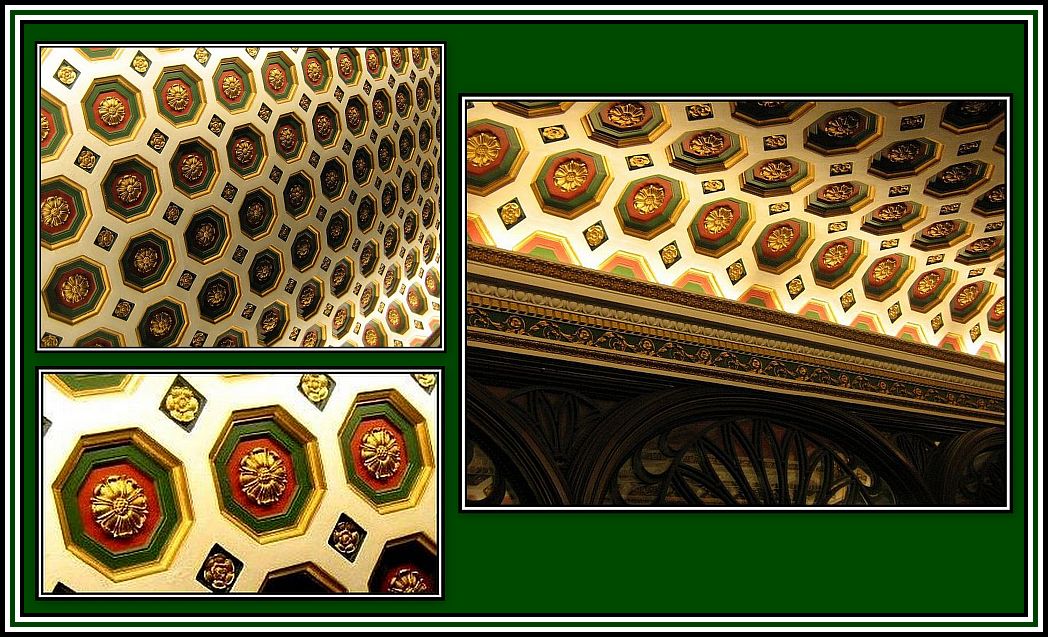 The Foyer Ceiling
The Foyer Ceiling
Right: decorative frieze between the heavy wooden doors and coffered ceiling
The foyer extends into an atrium that leads to the auditorium, stairs to the upper levels and to the bar. Here the ceiling displays a sun-like centre piece with mirrors placed between the rays. A chandelier extends down from the centre of the ceiling elaborately decorated golden chain to support the fixture. The chandeliers of the Foyer are remarkably similar in design to those that were found in many of the later Granada Theatres.
The decor of the foyer is, to say the least, remarkable and I defy anyone not to gasp when they see this site for the first time.
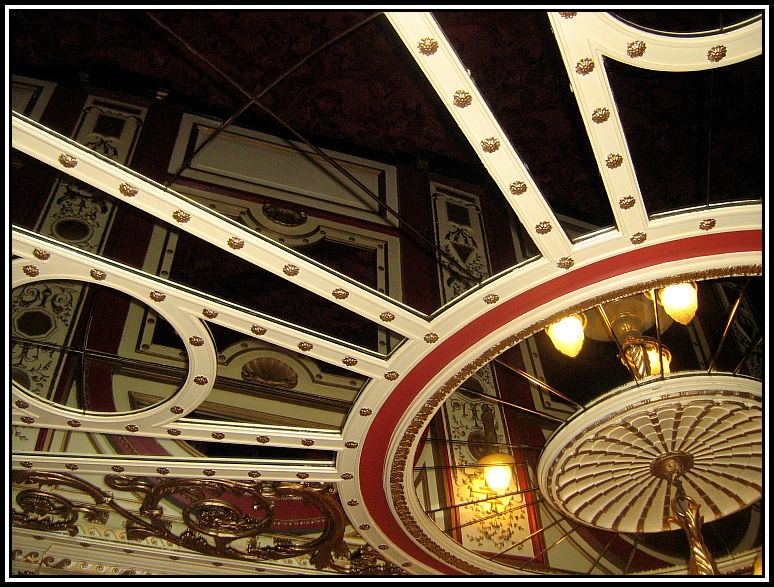 Ceiling with a stunning sun-like centre piece and mirrors between the rays
Ceiling with a stunning sun-like centre piece and mirrors between the rays
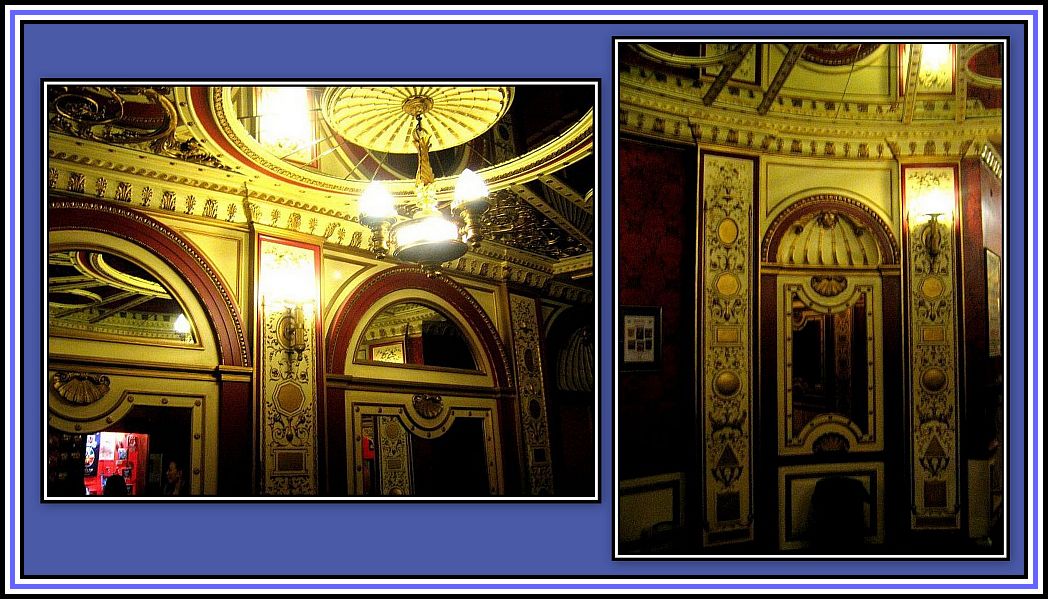 Decorative walls beneath the mirrored ceiling. Note the round-headed mirrors.
Decorative walls beneath the mirrored ceiling. Note the round-headed mirrors.
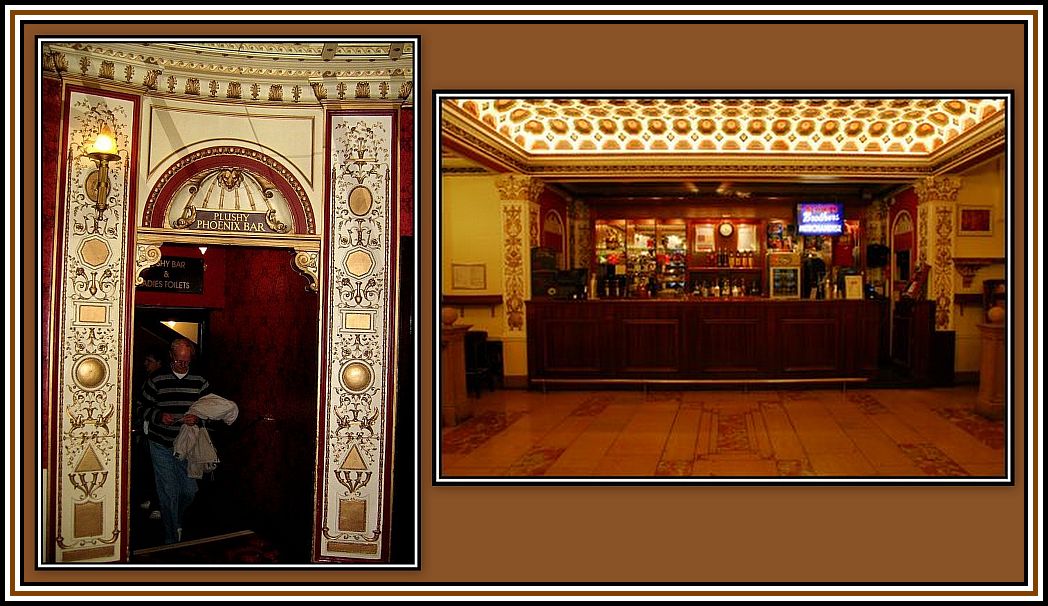 The Plushy Phoenix & Noel Coward Bar
The Plushy Phoenix & Noel Coward Bar
Left: entrance to the Plushy Phoenix Bar;
Right: the Noel Coward Bar with coffered ceiling and decorative floor.
This bar was opened in 1969 by Noel Coward.
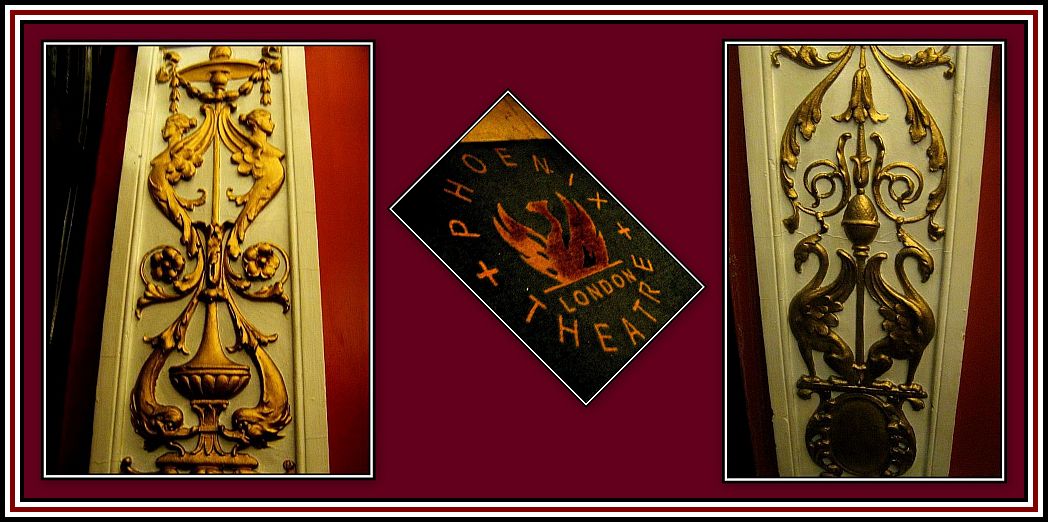 Left & Right: Details of the decoration of the pilasters found throughout the theatre
Left & Right: Details of the decoration of the pilasters found throughout the theatre
Centre: motif of the mat at the entrance to the theatre
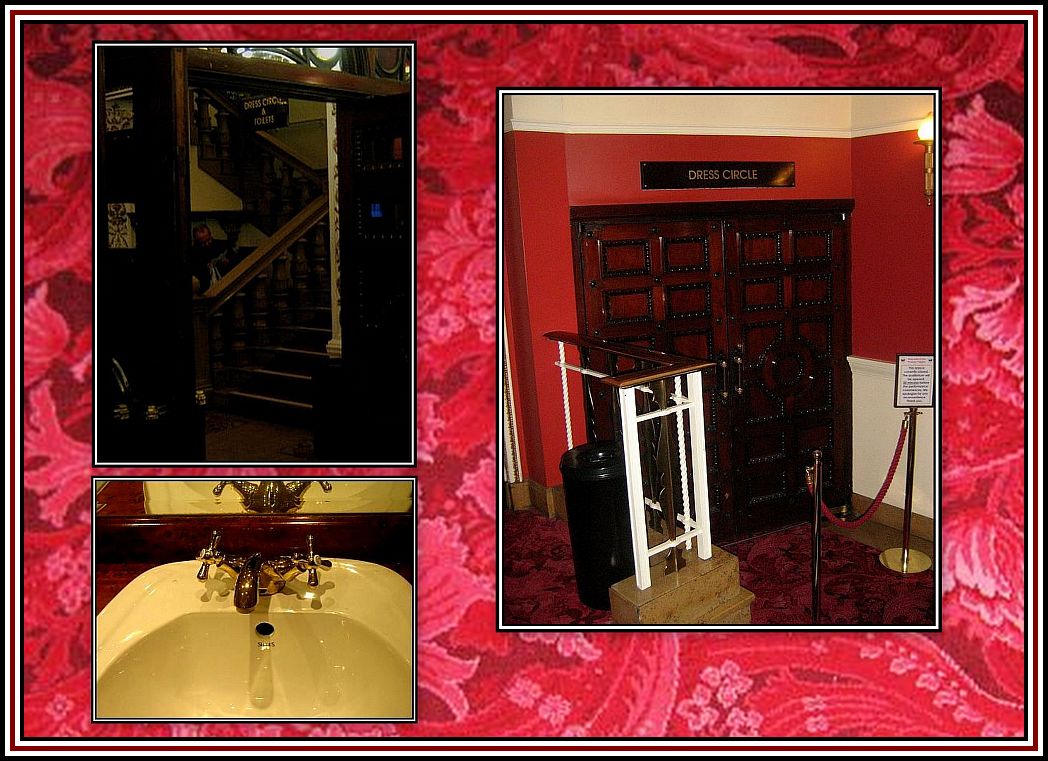 Top Left: stairs in the Foyer leading to the Dress Circle;
Top Left: stairs in the Foyer leading to the Dress Circle;
Right: entrance to Dress Circle
Bottom Left: sink with golden taps
The background shows details of the carpet found throughout the theatre.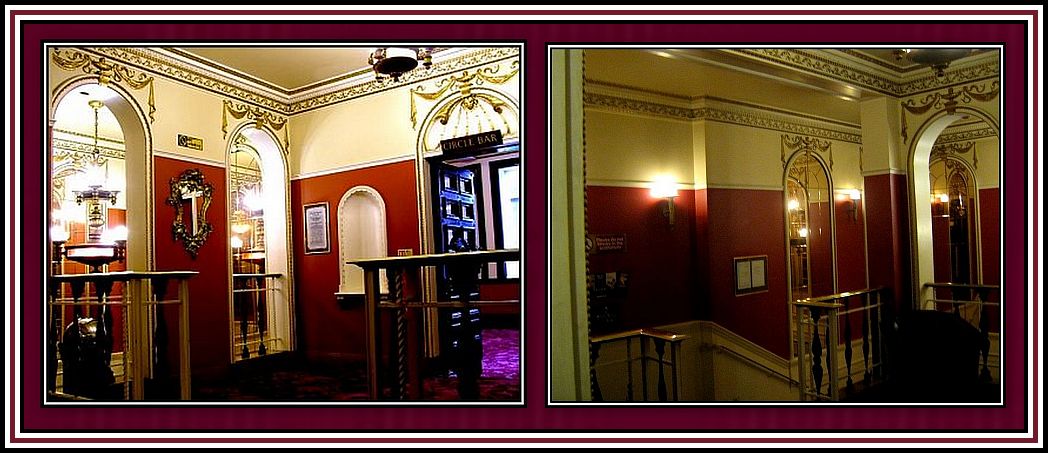 The walls of the stairways leading to the upper levels are decorated
The walls of the stairways leading to the upper levels are decorated
with round-headed mirrors, which became a feature of the Foyers of a number of the later Granada Theatres.
——oooOOOooo——
The auditorium of the Phoenix Theatre is as gloriously decorated as the Foyer in gold and magenta. It is very tall with both a Dress Circle and Balcony, but is relatively narrow and has a seating capacity for 1,028. The Proscenium Arch together with the frieze above it, which here extends across to the side walls of the stalls together with the three round-headed arches containing the Box seats on either side of the stage became the basic design followed in the auditoria of later Granada Theatres. At the time of opening, the Boxes were draped with red velvet curtain. In the later Cinemas/Theatres, the Boxes with their round-headed arches became covered with decorative grille work and the frieze was often reduced in width and not always extended to the side walls.
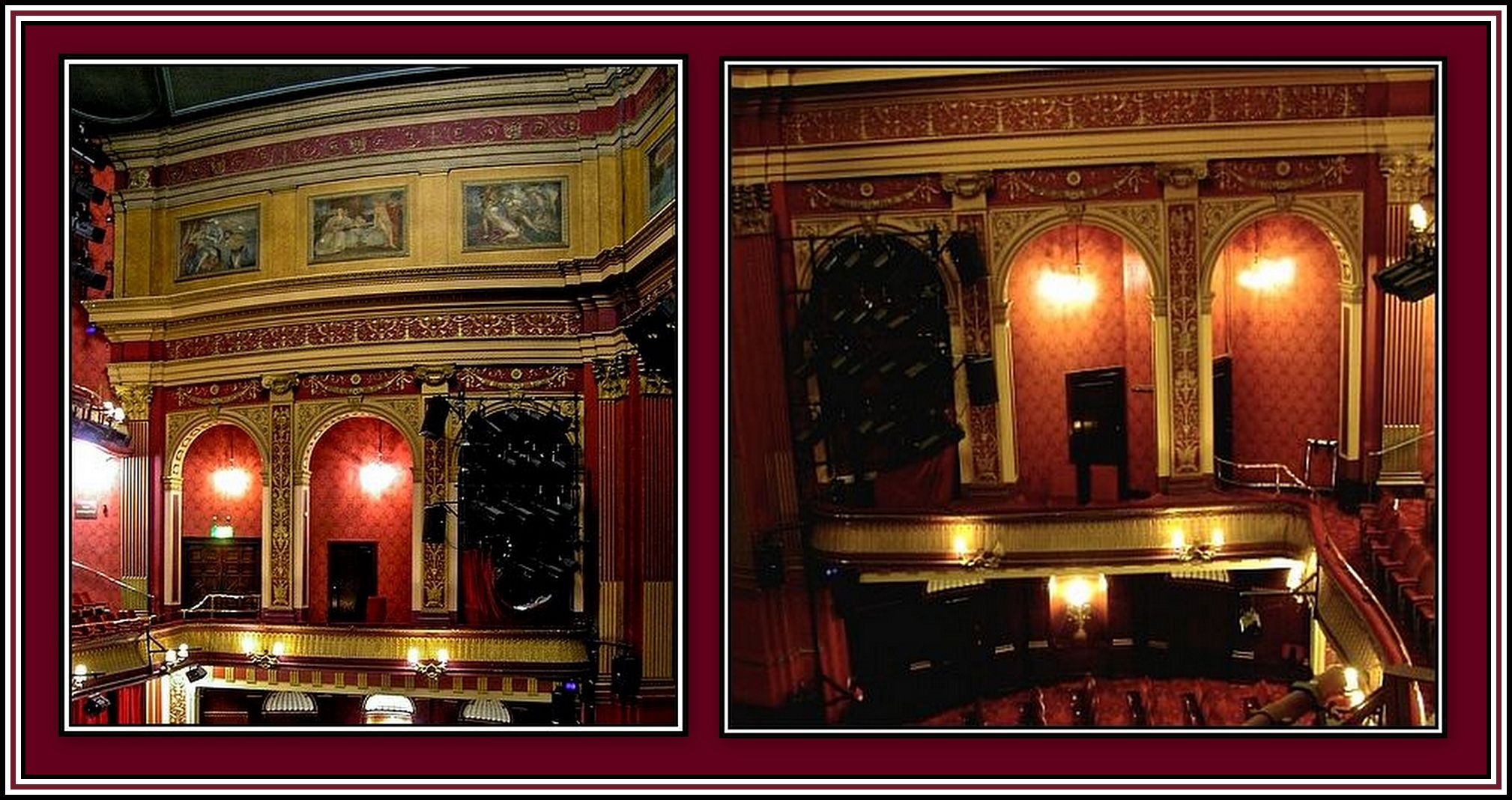 The Boxes were draped with red velvet curtain at the time of the opening
The Boxes were draped with red velvet curtain at the time of the opening
Left: the Boxes on the left-hand side of the auditorium
showing the freizes and some of the reproductions
Right: right-hand side Boxes
The ceiling above the front stalls is in the form of a dome, which has a chandelier hanging from its centre. In later Granada Theatres, the same design of chandelier was regularly seen while the dome became flattened and a decorative centre piece added.
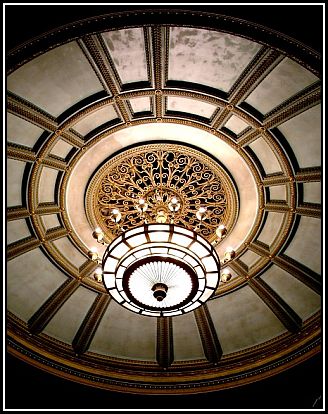 Central Dome and Chandelier over the Stalls
Central Dome and Chandelier over the Stalls
The side walls of the Upper Circle are remarkably plain with no decoration, which allows the eye to concentrate on the stage area.
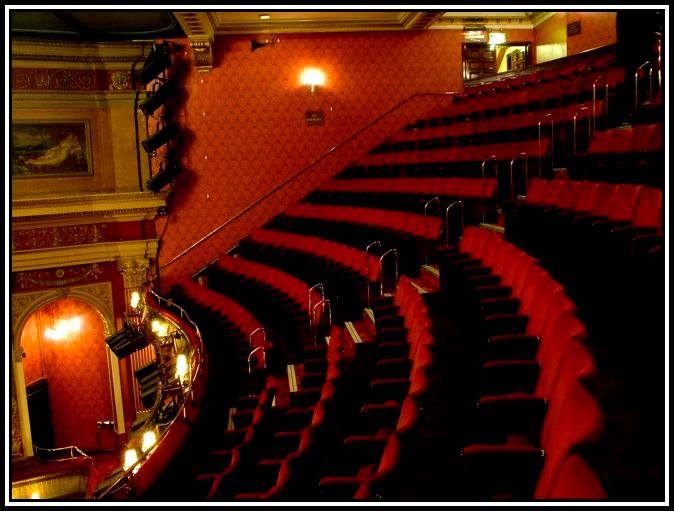 The Upper Circle – note the undulating rows, a feature of Cecil A. Massey
The Upper Circle – note the undulating rows, a feature of Cecil A. Massey
In contrast to the side walls of the Circle, the side walls of the Stalls and the area above the Proscenium Arch are decorated with two friezes and nine reproductions of famous Venetian paintings, which was the work of Vladimir Polunin.
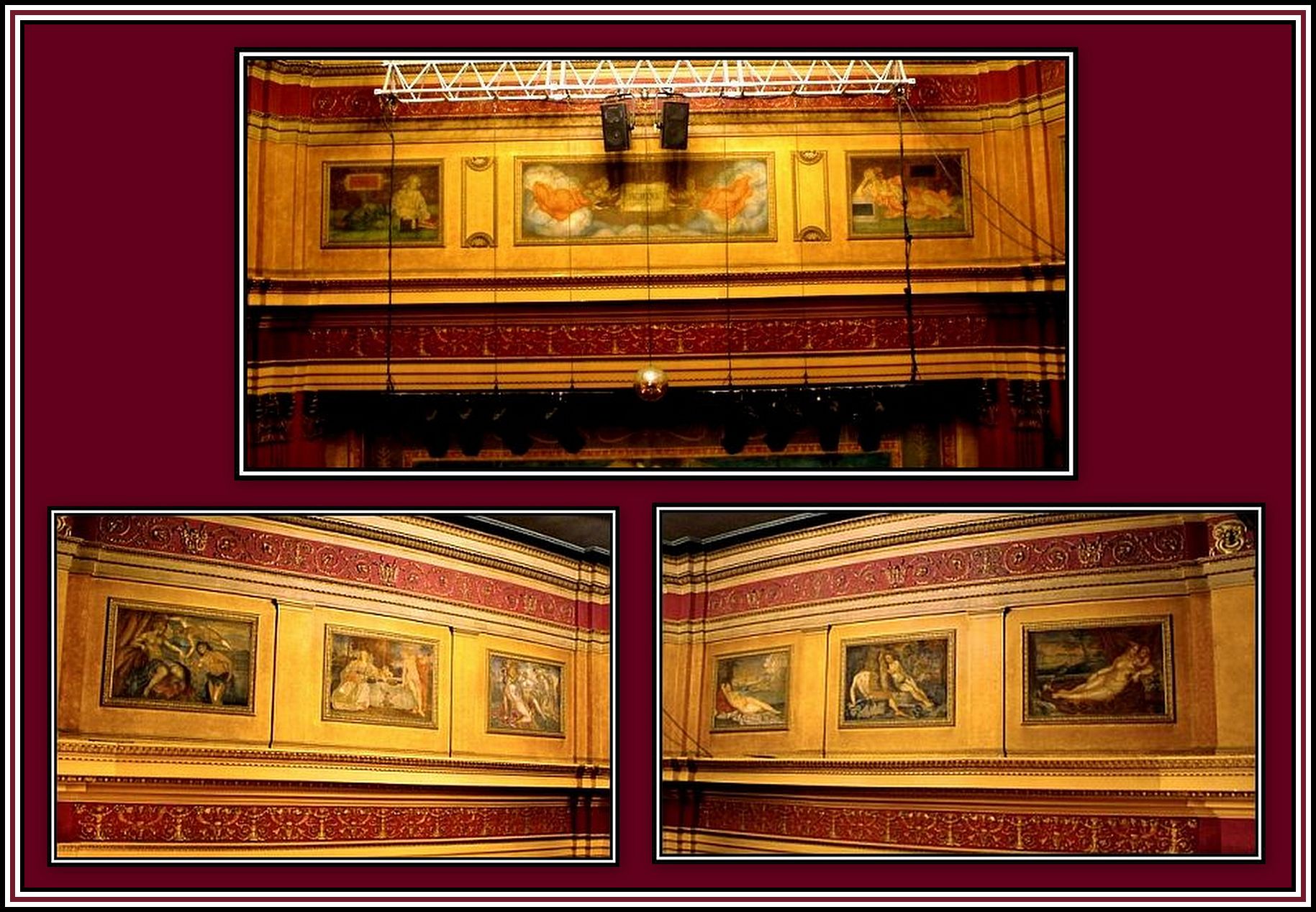 Friezes & Reproductions of Venetian Paintings
Friezes & Reproductions of Venetian Paintings
Top: those over the Proscenium Arch; Left: those over the left Boxes;
Right: those over the right Boxes.
Vladimir Jacolievitch Polunin (1880–1957), who like Theodore Komisarjevsky, was a Russian emigré, and first came to England as the main scene designer of Diaghilev’s Ballets Russes. Together with his English wife, Elizabeth Violet Hart, they had a studio at 48 Floral Street, Covent Garden. It is of interest to note that in 1919, Picasso worked here to produce the set and stage curtain for Diaghilev’s production of The Three-Cornered Hat, which helped revive the fortunes of the Ballets Russes.
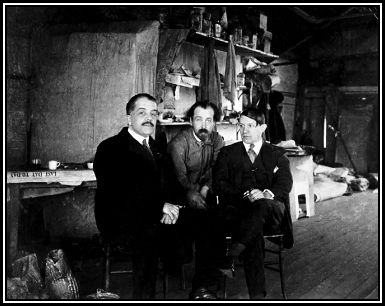 At the studio at 48 Floral Street, Covent Garden in 1919
At the studio at 48 Floral Street, Covent Garden in 1919
Left, Serge Diaghilev; Middle, Vladamir Polunin; & Right, Pablo Picasso
Mr. Polunin became a lecturer in Decorative Design at the Slade School of Fine Art. In addition to producing the reproductions at the Phoenix Theatre, he was responsible for the painted panels present on the main staircase up to the Balcony of the Granda Theatre Woolwich.
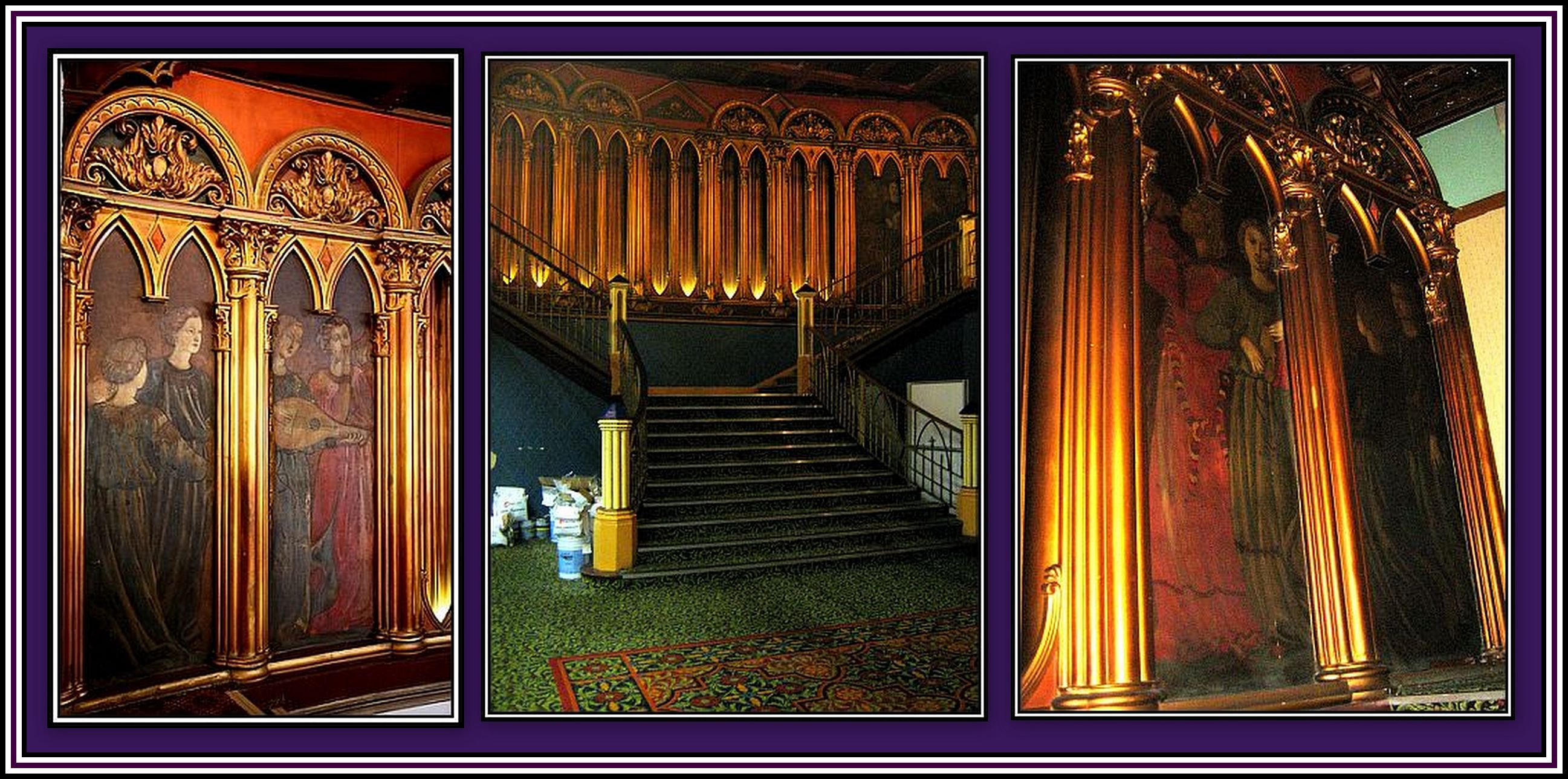 Painted panels by Vladamir Polunin
Painted panels by Vladamir Polunin
at the Granada Theatre Woolwich
To produce his reproductions at the Phoenix Theatre, Mr. Polunin worked from black and white photographs of the originals. He produced three paintings each for the side walls and for the area above the Proscenium Arch plus another on the Safety Curtain. He reproduced three paintings by Tintoretto (1518-1594), two by Titian (1488 or 1490-1576) and one each from the works of Giorgione (1477 or 1478-1510), Pinturicchio (1454-1513) and Filippo orbizzin (which makes eight reproductions; I am unable to learn whose work forms the basis of the ninth reproduction).
Unfortunately I can find no information about Filippo Corbizzin and no photographs of his work at the present time. I can also find no information readily as to which reproduction is which at the Phoenix Theatre. I will endeavor to find out and when I do, be sure that I will introduce the information here. In the meantime, I am adding some examples of the work of as many of these Masters as I can in order to give the reader some indication of their remarkable talents.
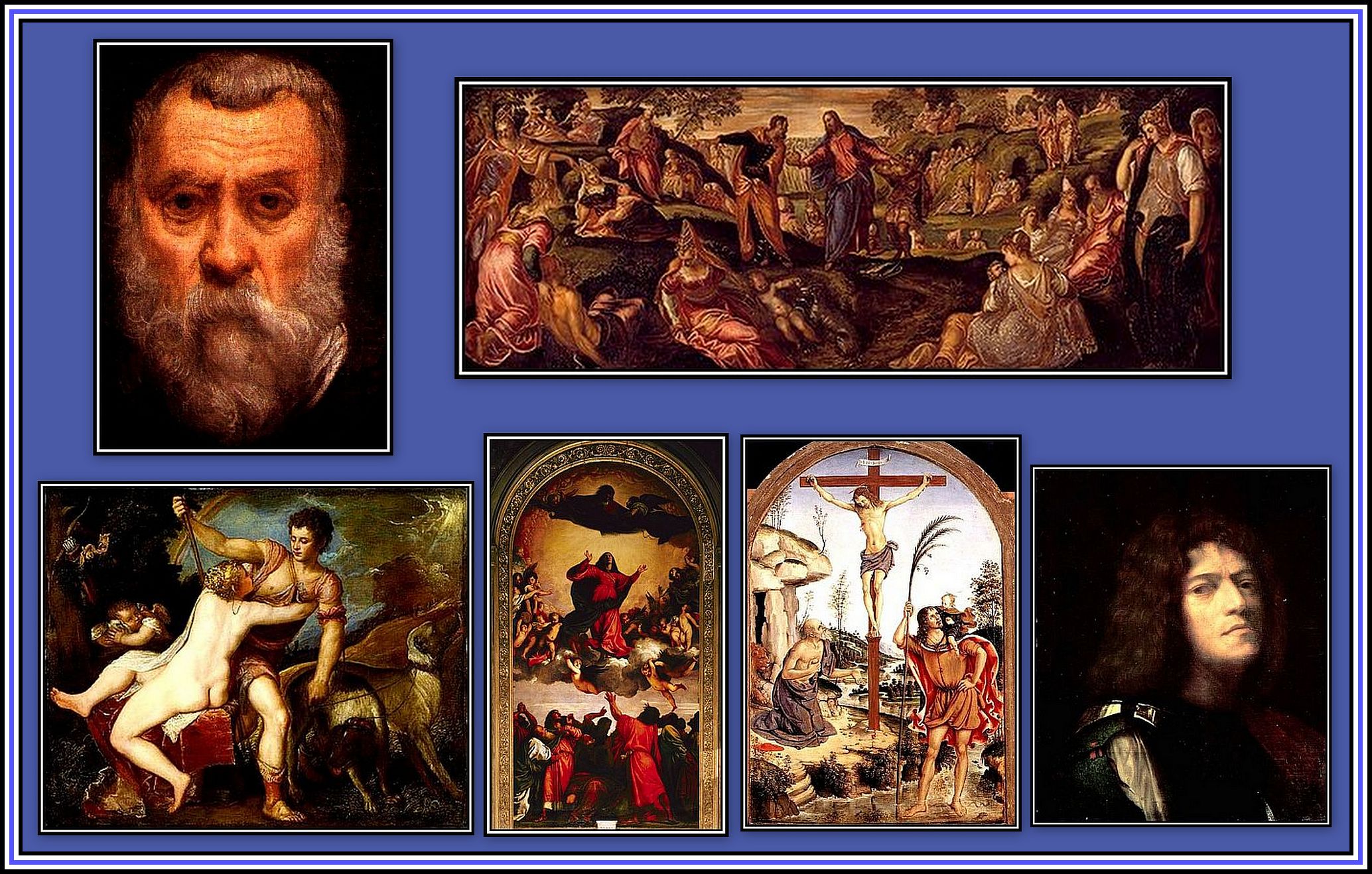 The Masters
The Masters
Top left: Self-Portrait by Tintoretto; Top Right: The Miracle of Love & Fishes by Tintoretto;
Bottom, from left to right: Venus & Adonis by Titan; Assumption of the Virgin by Titan;
The Crucifixion with St. Jerome & St. Christopher by Pinturicchio; &
Self-Portrait as David by Giorgione
Vladamir Polunin also painted a reproduction on the Safety Curtain at the Phoenix Theatre. This is a somewhat unusual situation since most theatres did not have this feature. Many theatres used the Curtain at one time, as a screen for advertisements during the interval. Mr. Polunin reproduced The Triumph of Love by the Florentine artist, Jacopo del Sellaio (1441-1493) on the Curtain.
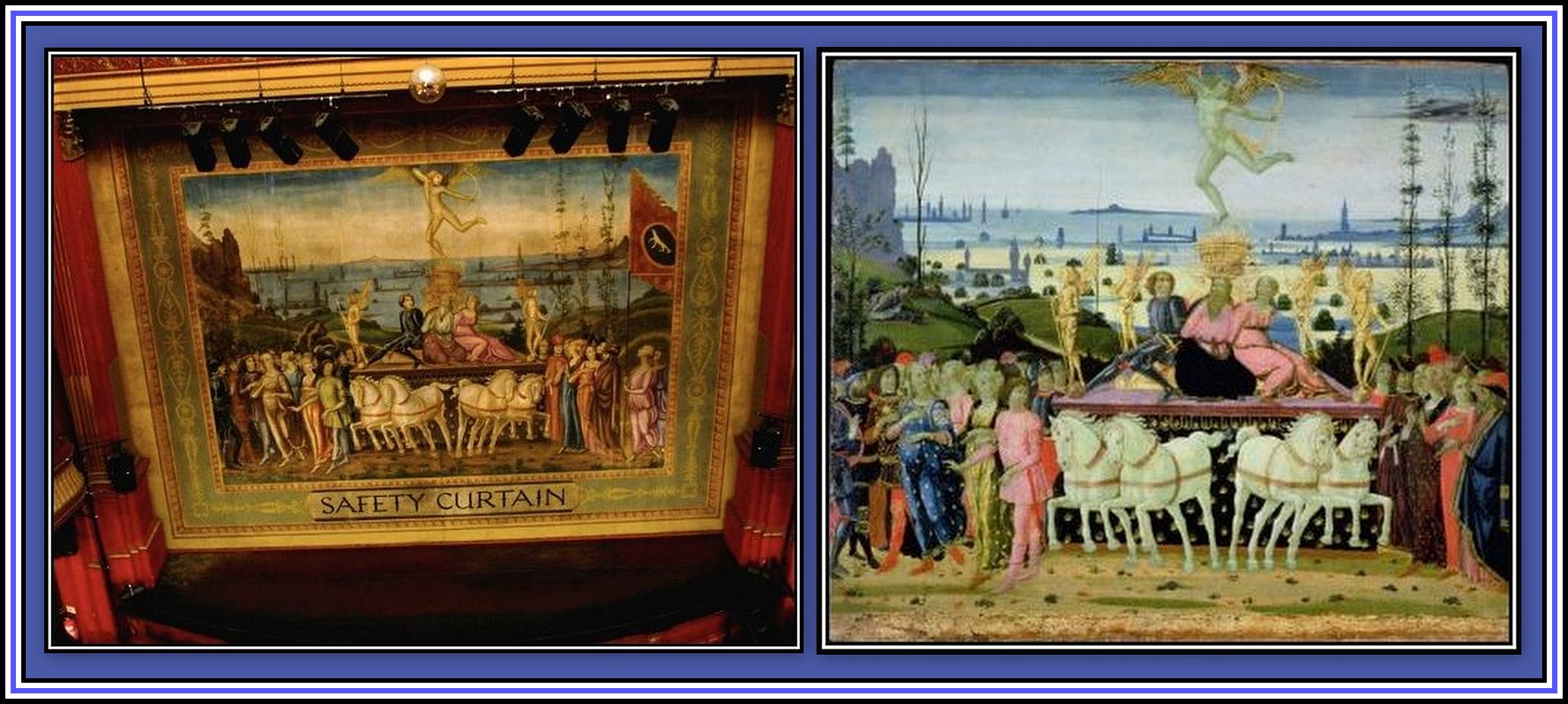 The Triumph of Love
The Triumph of Love
Left: reproduction on the Safety Curtain; Right: the original painting
——oooOOOooo——
This glorious theatre opened in September 1930, just two weeks after the Granada Walthamstow, with the original production of Noel Coward’s play, Private Lives. Since then, a variety of plays and musicals have found a home at the theatre. In addition, the theatre was used as a cinema with the showing of Rene Clair’s Le Million and for cinema trade shows.
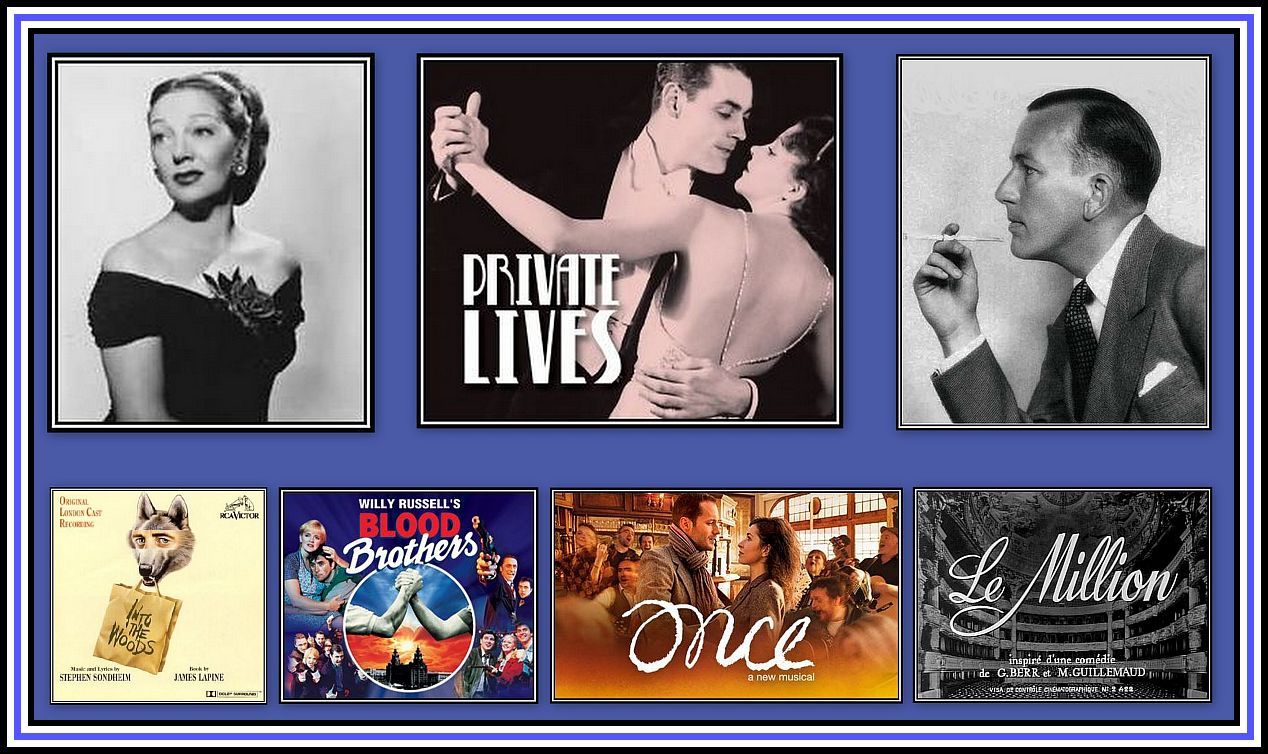 Top Left: Gertrude Lawrance; Top Right: Noel Coward
Top Left: Gertrude Lawrance; Top Right: Noel Coward
The theatre proved not to be a financial success for Mr. Bernstein and he sold it in March 1932 to Victor Luxemburg. Mr. Luxemburg did not do well as owner and unfortunately it had passed to the Receiver by December 1933.
The theatre is a Grade II listed building and today remains essentially unaltered in design. It is currently owned and operated by the Ambassador Theatre Group (ATG) and remains, without doubt, one of London’s most glorious theatres.
Please allow me to offer my opinion here …….. I think that, without question, the Phoenix Theatre IS the most glorious theatre in London and is a suitable memorial to the memory of the great Theodore Komisarjevsky and also allows the talents of Validmir Polunin not to be forgotten.
——oooOOOooo——
ACKNOWLEDGMENTS
Some of the history of the theatre presented here came from
The Granada Theatres by Allen Eyles. I am grateful to Mr. Eyles for this great book.
——oooOOOooo——
I would like to draw the reader’s attention to the terrific website maintained by
Clair Sedore,
world theatres.com
——oooOOOooo——
Click here to go to PART NINE: THE GRANADA THEATRE TOOTING
——oooOOOooo——
Click here to return to PART SEVEN:
THE GRANADA THEATRE WALTHAMSTOW
——oooOOOooo——
Click here to return to THE GRANADA THEATRE CIRCUIT
Home Page
——oooOOOooo——
Click here to return to the TABLE OF CONTENTS
——oooOOOooo——

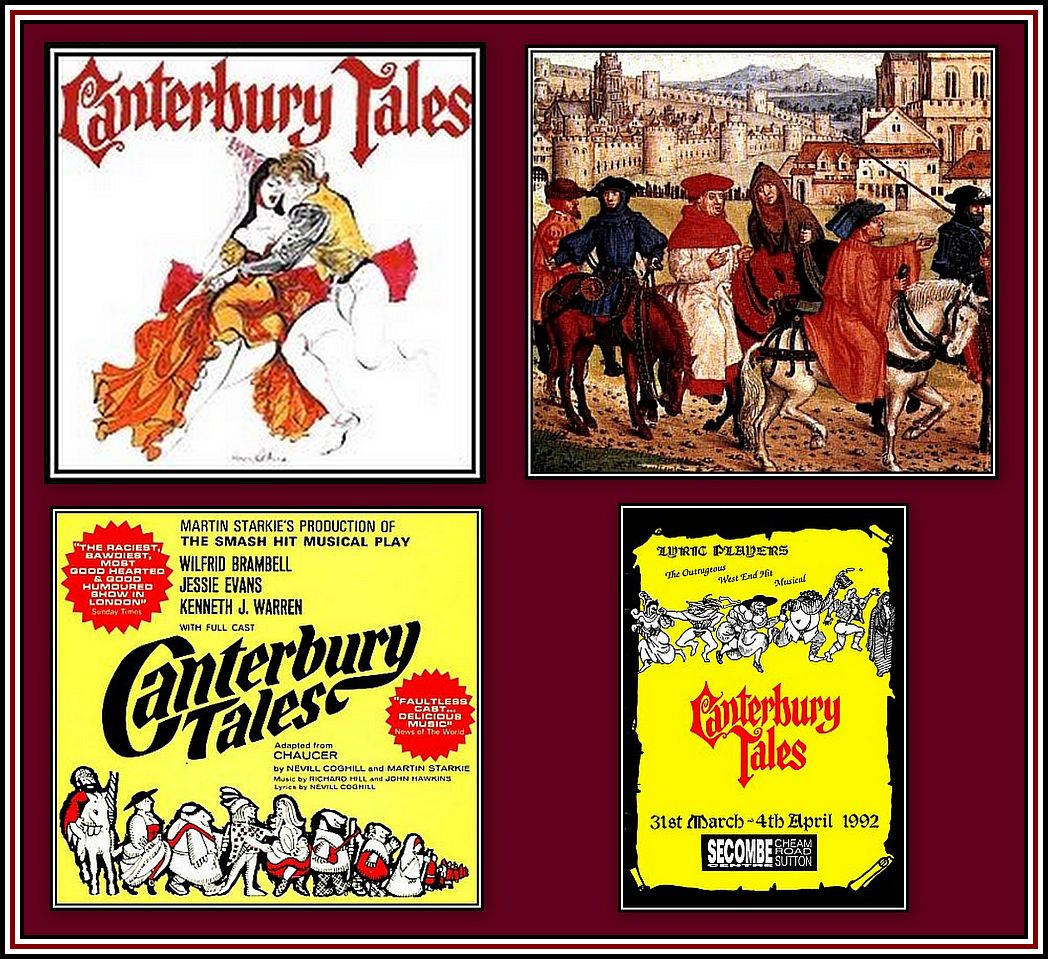

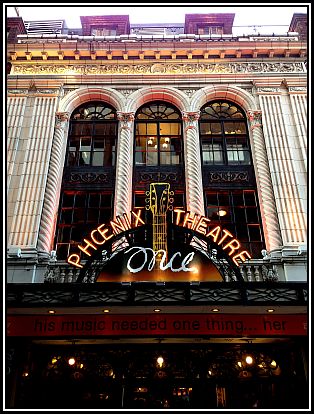
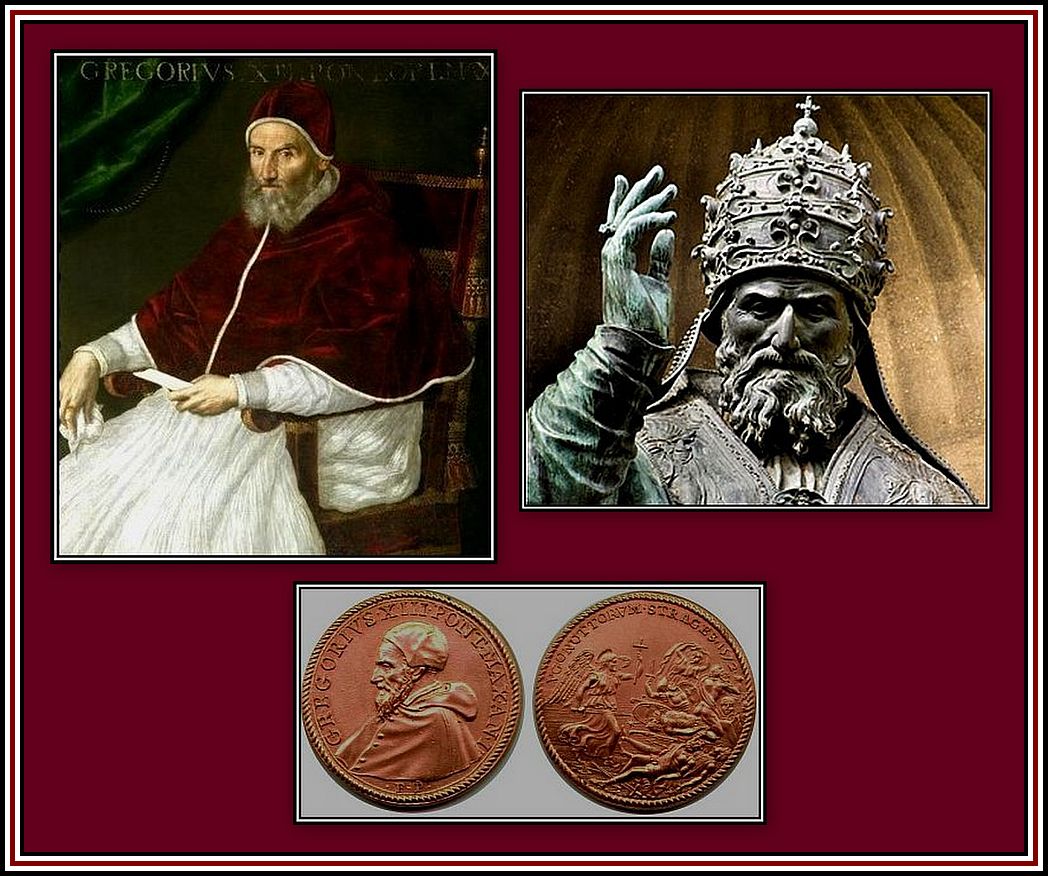
Hello,
I am looking for the source of the photo of Picasso and Diaghiliv and Polunin at Covent Gardens. Can someone direct me to the right place?
Million thanks in advance and kindest regards,
Katherine Bang
212-286-7691
The Phoenix Theatre is one of the few theatres I hadn’t been to.
I have just seen the magnificent ‘The Last Tango” which was so much more than a dance show. Enjoyed immensely.
I thought The Phoenix was exquisite and was most especially taken with the mirrored sun-like ceiling – very unique.
The Phoenix Theatre is a beautiful art deco grade listed building. It’s stunning and takes you back to bygone era of exquisite decor. David Cassidy performed in Blood Brothers at the theatre 🎭 a plaque commemorating his performance at the Phoenix Theatre was paid for by his fans and erected with an unveiling ceremony on 21st September 2018 and was unveiled by DJ Mike Read . I was one of the organisers of the event and fans gather to celebrate this for David . The plaque is placed above the stage door.
This is a video of the days events with fans at the the days events
https://youtu.be/ZvZY7u5dPgM?si=gEpmbMbnNgoJKrqF
Camellia: Thanks so much for visiting my website and for informing us of the plaque. I saw it when I last visited London. Regards. Charles